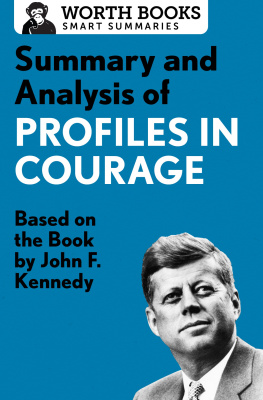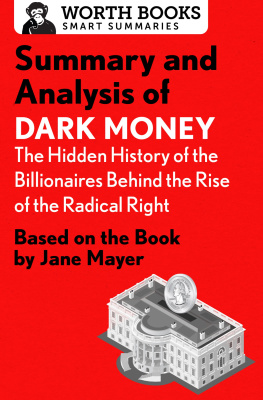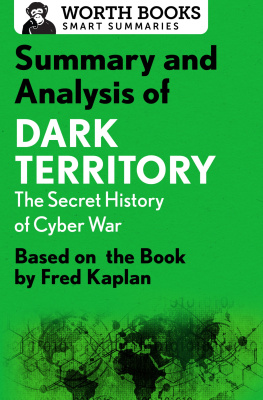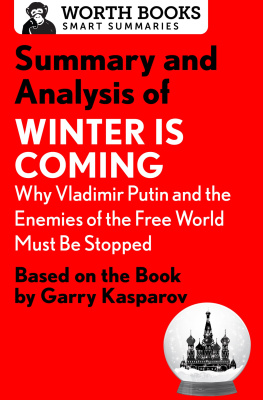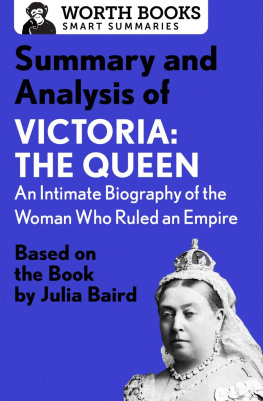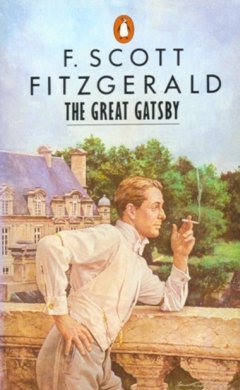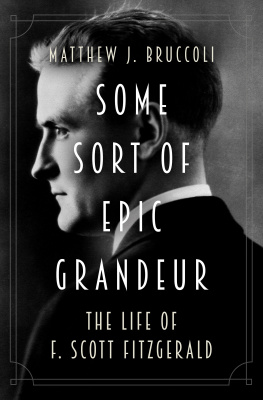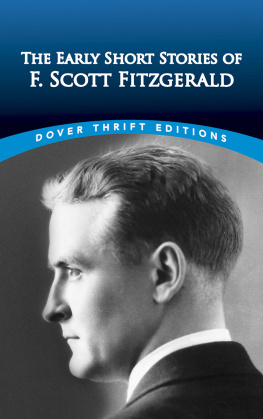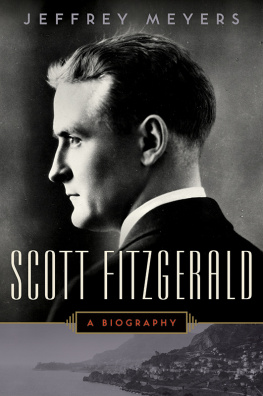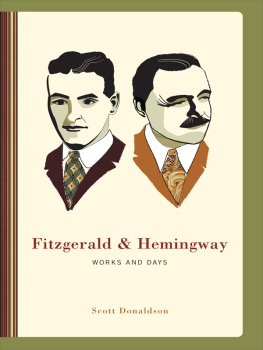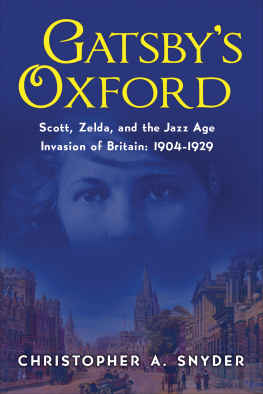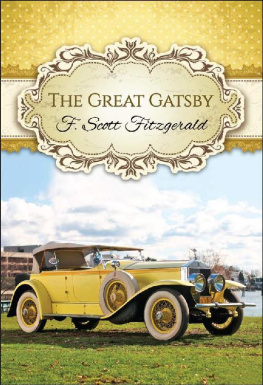Summary and Analysis of
The Great Gatsby
Based on the Book by F. Scott Fitzgerald

The summary and analysis in this ebook are meant to complement your reading experience and bring you closer to a great work of fiction. This ebook is not intended as a substitute for the work that it summarizes and analyzes, and it is not authorized, approved, licensed or endorsed by the works author or publisher. Worth Books makes no representations or warranties with respect to the accuracy or completeness of the contents of this ebook.
Context
The Great Gatsby is set in New York during the Jazz Age, the years of excess during the 1920s that preceded the Great Depression. The frivolity of the era is immortalized in this classic novel through Jay Gatsbys elaborate parties, and the careless, old-money attitude of the Buchanans and their acquaintances.
The Great Gatsby captures the essence of the American Dream of the time and weaves it into an iconicand somewhat satiricportrait of the Roaring Twenties.
Originally published in 1925, Fitzgerald composed his masterwork, The Great Gastby , while living abroad in Europe.
World War I had just ended, and the mood in the United States was optimistic: New technologies were being introducedmodern motorcars for the masses, moving pictures, radioand economic prosperity seemed within reach for soldiers returning home from war and for the middle class that was abandoning the countryside and flocking to live in cities. Factories were being upgraded to serve a new and growing consumer market, and average citizens enjoyed additional leisure time, as housework became more mechanized.
The flapper lifestyle was in full swing, with women enjoying newfound freedoms in their work, their fashion and personal appearance, and, most notably, their ability to vote.
Success first came to F. Scott Fitzgerald, a young writer who grew up in an upper-middle-class family in St. Paul, Minnesota, with his first semiautobiographical novel, This Side of Paradise, published in 1920. Fame and fortune followed, as did the marriage to his great love, Zelda.
When considering The Great Gatsby , in which protagonist Jay Gatsby makes his fortune by bootlegging, one must also remember the 1920 ratification of the 18th amendment that banned the production and distribution of alcohol. Gatsby shows off his new money wealth by throwing lavish parties where the shallow congregate and look for opportunities to improve their own standing in society.
Overview
Nick Carraway leaves the Midwest to learn the bond business in New York. He rents a cheap house in West Egg, across the bay from the fashionable East Egg, where those with old money live. Nicks relative, the exquisite Daisy Buchanan, lives there with her husband, Tom. They invite Nick over for dinner, where he meets Daisys friend Jordan Baker. Jordan is as lovely as Daisy, though her cynicism contrasts with Daisys winsome manners.
Throughout dinner, Nick senses an uncomfortable tension between the Buchanans. Jordan hints this is probably because Toms mistress called the house again. Jordan also mentions that Gatsby must be Nicks neighbor, a name that makes Daisy react strangely. After dinner, Nick returns home to see his neighbor looking across the bay, staring at a green light.
A few days later, Tom takes Nick out for a drive. They go through a desolate stretch of land called the valley of ashes. Overlooking the valley is a billboard advertisement for the oculist Doctor T. J. Eckleburg, whose ghostly eyes peer out over everything. Toms mistress, Myrtle, lives here with her husband, George B. Wilson.
Tom and Nick stop at Georges garage and Tom tells Myrtle to meet them in the city. At Myrtles apartment in the citywhere Tom pays the renta number of people come over for an impromptu party. Their worst qualities intensify as they continue to drink. Put off by their behavior, Nick tries to leave. The night ends with Tom punching Myrtle in the face for saying Daisys name.
Myrtles sad get-together contrasts with the wildly lavish parties Nicks neighbor throws. One weekend, Nick is invited to attend. The party is packed, but no one seems to know where or who the host is. When Nick finally meets Jay Gatsby, he finds him to be elegant, charming, and somehow quite separate from all of his guests. After talking with Nick, Gatsby has a private conversation with Jordan.
When she returns to the party, she reports vaguely that Gatsby has just told her incredible things. One day, Gatsby invites Nick to have lunch in the city. On the drive, Gatsby seems agitated and wonders what Nick thinks of him. He doesnt want Nick to believe the rumors, so he recounts his life story. Yet there is an uncertainty behind Gatsbys words that makes the story seem suspect. Nick grows so incredulous he almost laughs. But then Gatsby presents him with two pieces of evidence: a photograph from Oxford and a medal from the war. Both of these convince Nick that, despite his lingering skepticism, Gatsbys story must be true.
At lunch, Nick meets Gatsbys business partner, Meyer Wolfsheim. He claims to be very sentimental, but his shifty eyes and odd mannerisms seem to support the opposite. Wolfsheim is rumored to have fixed the World Series and this makes Nick wonder if Gatsby is involved in illegal business.
Later in the day, Nick has tea with Jordan who relays what shed heard from Gatsby at his party. Gatsby and Daisy had been in love when they were younger, but Daisy couldnt marry him because he was poor. Now that Gatsby has made a name for himself, he wants to see her privately, and he hopes Nick will help.
Despite being annoyed at the secrecy, Nick invites Daisy to his house for tea so the two can meet. Gatsby, in a fit of nervous perfectionism, sends over servants to fix up the place. He arrives early and is so stressed, he almost flees before Daisy arrives.
Tea begins awkwardly and Nick decides to give the two some time alone. When he returns, Daisy is crying and Gatsby is practically glowing with happiness.
After tea, they tour Gatsbys house. Daisy is unstable with emotion, but Gatsby follows her in awe, like hes seeing everything for the first time through her eyes. As they look out onto the grounds later on, Gatsby mentions the green light. He seems bewildered how his newfound happiness has instantly eclipsed the longing he once felt. The green light is once again just a light. Nick wonders if the same thing will happen when the real Daisy is compared to Gatsbys dream.
Throughout the summer, Gatsbys notoriety grows. He becomes so famous that a reporter comes to his house wanting an interview. Here, Nick reveals Gatsbys true history, though he explains he doesnt learn these facts until later. Jay Gatsby grew up as James Gatz, the son of unsuccessful farmers. Unsatisfied with his poor midwestern life, Gatsby began to work on Lake Superior. There he met Dan Cody, a copper tycoon, who hired him as his personal assistant. Under several years of Codys guidance, James Gatz disappeared and Jay Gatsby became reality.
One Saturday night, Tom and Daisy attend a party at Gatsbys mansion. Toms presence makes the whole thing oppressive. Afterward, Gatsby is depressed because Daisy seems to not understand things anymore. He doesnt know why she wont leave Tom. Nick warns Gatsby not to ask too much of her, as the past cant be repeated. But Gatsby wont listen. He truly believes he will be able to recreate what they once had.
One sweltering afternoon, the Buchanans, Gatsby, Jordan, and Nick have lunch. Tom realizes that Daisy is in love with Gatsby and, in a rage, forces them to go into town. They stop at the garage and George tells Tom he and Myrtle are moving west because shes been having an affair. This only makes Tom more irate. In the city, Tom attacks the truth of Gatsbys past. Gatsby counters by telling Tom that Daisy never loved him. Gatsby tries to get Daisy to admit this, but she wont.
Next page

